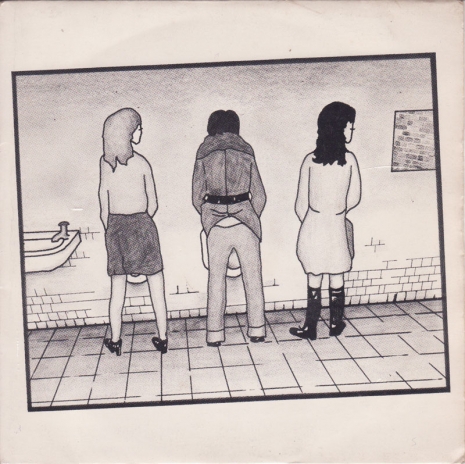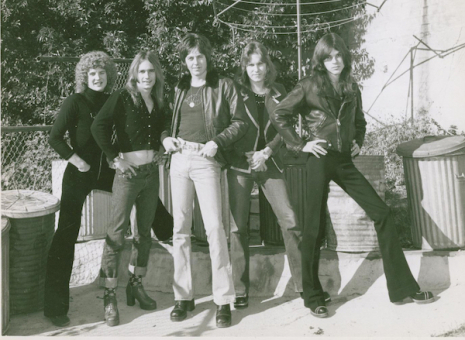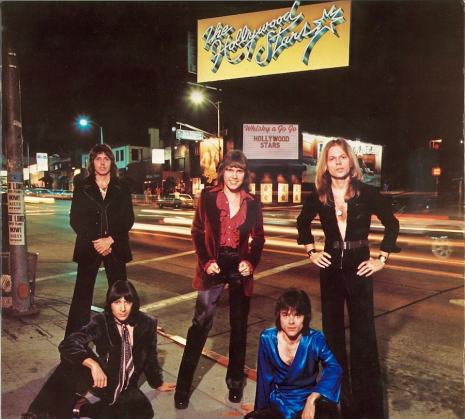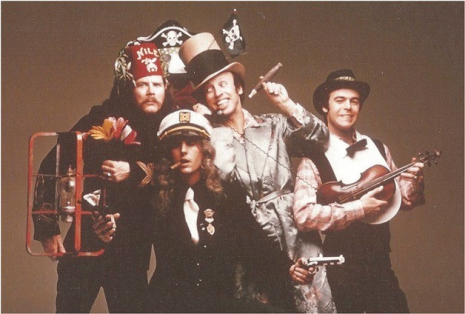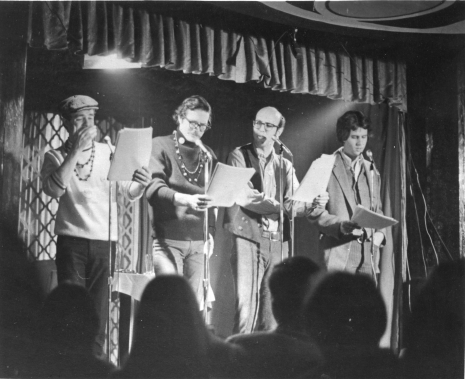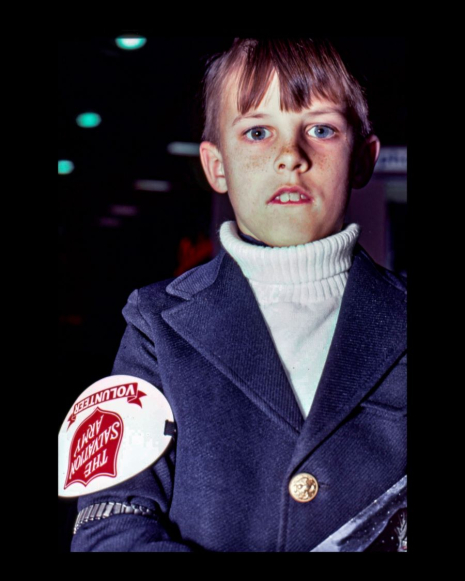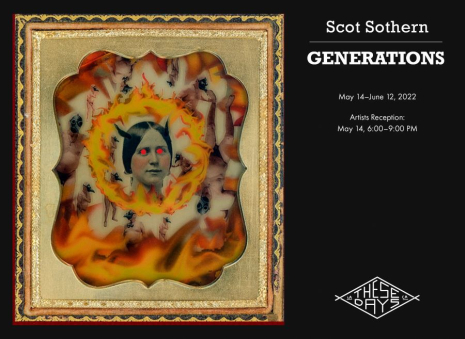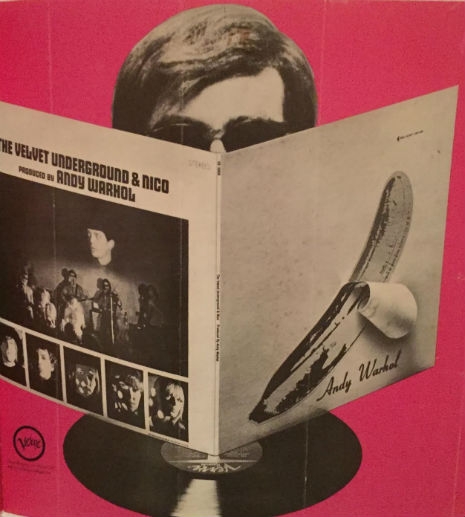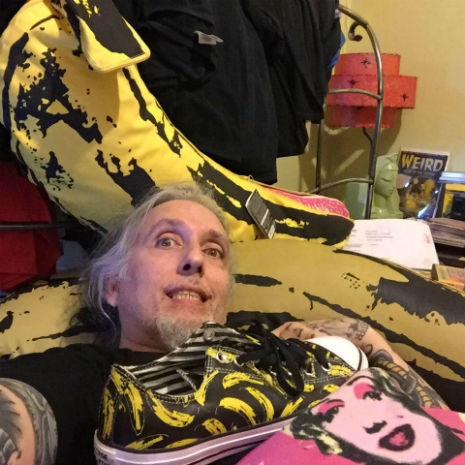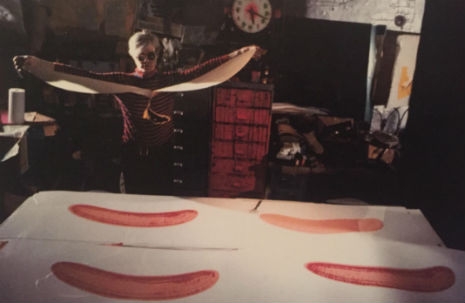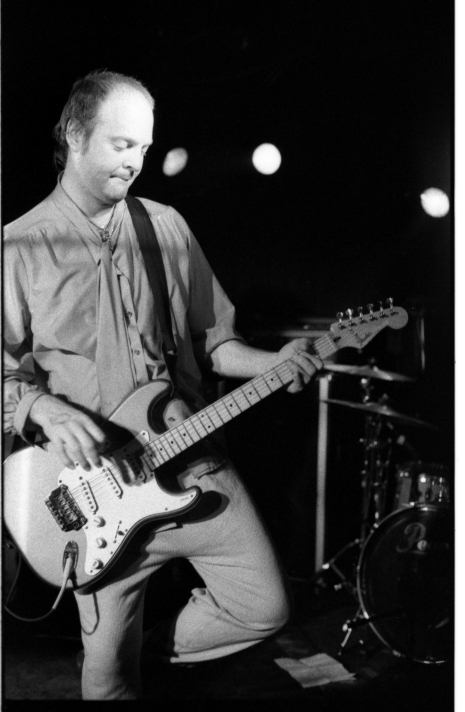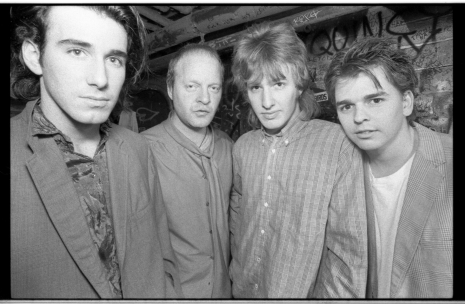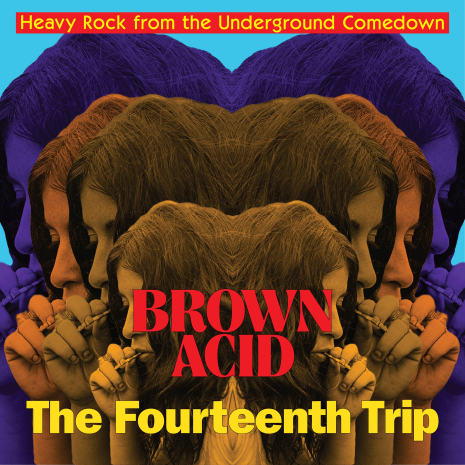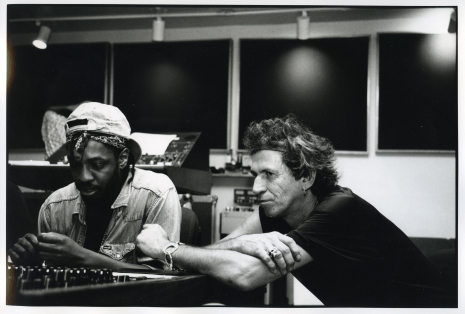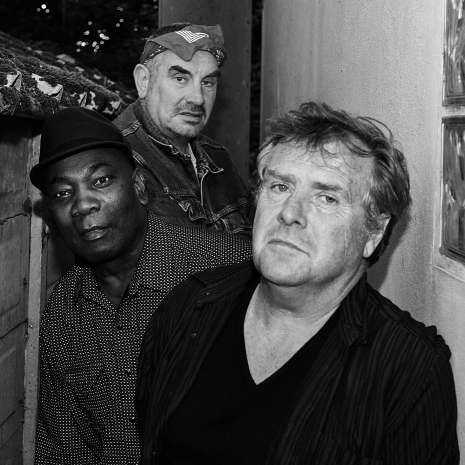
‘KILL HIM!’: ‘Wormwood’ on stage (courtesy of Cherry Red Records)
The new Wormwood box set, the latest installment in Cherry Red’s pREServed series of Residents reissues, runs to nine CDs etched with nearly nine hours of music. Not quite James Earl Jones Reads the Bible territory (sixteen CDs, nineteen hours), it nevertheless presents the Residents’ 1998 biblical epic at a scale appropriate to the form. Perhaps God, sufficiently enraged by humanity to send plagues, pestilences, fires, and hurricanes, has also seen fit to unleash this mighty flood of scriptural content, which makes the meager 203 minutes of the Charlton Heston Presents the Bible four-DVD set look like a positive insult to the Almighty.
Wormwood: Curious Stories from the Bible, by one count the Residents’ twenty-third album, draws most of its lurid tales of rape, incest, and murder from the books of the Old Testament (though they also give us a Judas who understands betraying Jesus as his divine calling, as well as a five-and-a-half-minute instrumental based on Revelation). There are surprising takes on familiar stories—the same chapter from the Book of Daniel that inspired Johnny Cash to write “Belshazzar” moved the Residents to write “God’s Magic Finger,” and “Bathsheba Bathes” gives a decidedly less pious take on David than Leonard Cohen’s “Hallelujah”—and songs based on tales few other songwriters have dared to tell, like Jael pounding a tent peg into Sisera’s skull while he sleeps.
Though Wormwood boasts more circumcisions than any rock record since Saccharine Trust’s Surviving You, Always, not to mention the winning contributions of Molly Harvey and Carla Fabrizio, it has never been my favorite Residents album. But listening to this box set has given me a new appreciation of the size and ambition of the Wormwood project, and how fruitful this period was for the group. In context with eight discs of supplementary material, the original album comes to seem like a preliminary sketch for a sprawling creation that kept the Residents busy for about four years, and included some remarkable work.
The Residents do not, of course, grant interviews, but I was able to contact Homer Flynn, the president of the Cryptic Corporation, and Richard Anderson, who oversees the pREServed series at Cherry Red Records, and subject each of them to a battery of haranguing and hairsplitting questions about matrix numbers, obi strips and session dates. Choice excerpts follow. I should mention that Richard drew my attention to a Residents compilation LP that had escaped my notice called Leftovers Again?!, issued for Record Store Day last year. It starts with a concentrate of the legendary, unreleased early recording Rusty Coathangers for the Doctor and proceeds through material from the Residents’ tape archive throughout the Seventies. Much of the LP consists of “RDX” (as in “redux,” I believe) mixes, new presentations of the original recordings of beloved Residents songs that often feature sounds from the multitrack tapes that didn’t make the final mix.
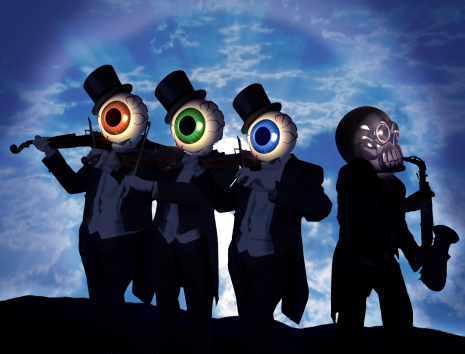
The Residents, 1998 (courtesy of Cherry Red Records)
Homer Flynn
As it happens, I was in the audience at the beginning of the tour in Boston, so I didn’t really realize how much the material evolved and changed after that. Could you talk a little bit about how the show changed when it went on the road?
Well, you know, Residents stuff usually does change. They do albums and then—maybe this is typical of a lot of artists, I don’t know—but it’s kind of like, when somebody writes and records something, in a lot of ways that’s just a kind of first, brief glimpse into the material, and then as they start to perform it, they find out more and more what they feel like it wants to be, and more how it works, and particularly how it works in front of an audience. So honestly it’s kind of an unpredictable path that it takes, many times.
Another example: when they were doing the Cube-E tour, which was like ten years earlier, you know, the second half of it was all Elvis songs, and one that just really came to life so much in performance was “Teddy Bear.” You know, Elvis sang it as such a light, upbeat pop song, and the Residents just felt like there were all these really incredible, almost like S&M undertones in it, and that then really came out in terms of the performance. So it’s kind of typical, I think, in a lot of ways with them for these things to change.
Part of being in front of an audience, maybe, seeing what works and what doesn’t?
Exactly. What brings out the attention and reaction of an audience makes a lot of difference.

‘Mr. Skull Superstar’ (courtesy of Cherry Red Records)
There are a lot of things I learned reading the liner notes to this box set. I guess [show opener] “Nober” was only played in Boston and then dropped from the set.
I’m not really sure what the thought was behind that, at this point. Maybe they felt like it was a little too long or a little too slow of a way to get into the set, and they felt like they needed something that grabbed the audience’s attention more? But, like I say, you’re reminding me of something I’d long forgotten about, really.
Well, in the Fillmore show—maybe you can help me sort out the chronology, here, Homer, I think the Fillmore show came before the tour?
Yeah, I think so. I think everything was put together in San Francisco at the Fillmore, and then they took it on the road.
The live version of “KILL HIM!” towards the beginning of that is really a fierce piece of music.
Well, I think that was one of the stronger pieces from that show and from that album.
Did that show have the big gamelan orchestra?
It had the gamelan in San Francisco, yeah. And then I think they came back later and did some shows at the Brava Theater in San Francisco, and I think they brought the gamelan back for that again, too. But once again, it was a long time ago, and while I’ve been through the box set, I haven’t actually revisited and listened to all that stuff again. So you’re more up on it and more familiar with it at this point than I am.

A Resident (courtesy of Cherry Red Records)
If you can remember, then, maybe you can talk about the origin of the project. Did the Residents read the King James Bible, or how did the project come into being?
Well, they were looking for a project, and for the Residents, often they start with some kind of a concept. Things can work in different ways; sometimes they just start recording, and the concept finds itself in that process. But often, they would like to try to find a concept first, and I don’t remember exactly where the idea of the Bible came from, but when it came out, it was like instantaneously: “Yes! Yes! The Bible!”
You’re looking at a bunch of people who all were, you know, White Anglo-Saxon Protestants growing up in the South, and they moved away from that; almost needless to say, they’re not really that religious. But they started seeing the Bible as so much of the underpinnings of Western culture on so many levels, and the more research they did with it, the more true that became. There’s just a million things in terms of so much of our laws, and morals, and stories, even people’s names, people that you run into on a very common basis. You find out, this woman’s name is Ruth; okay, well, that comes from the Bible. And there’s so many like that, it then became a very fascinating subject to explore and then dig into.
And I think particularly, once again, so much emphasis over recent culture has been put on the New Testament, which is Jesus, and love, and all that. But the really meaty stuff is the old stuff. That’s what really got them excited.
I remember wondering at the time if the Residents ever felt overwhelmed by the heaviness of the material. It’s not like the Residents’ material is always happy, but this is just like unrelieved rape, murder, God wants more foreskins—
Yeah, mountains of foreskins. Yeah, right, exactly. I think they were kind of blown away by a lot of it, honestly. But once again, that just reinforced that decision to be moving in that direction, using that as content for their music.
When they were choosing the stories, were they looking for anything in particular? Was it the stories that jumped off the page?
They did research. One of the things they weren’t necessarily aware of—it’s obvious, I guess, when you think about it, but they weren’t necessarily aware of it—you know, what we call the Old Testament is the Jewish Bible, and it’s kind of ironic in a way that you can have these ideological conflicts between Christians and Jews when they all kind of base so much of their religion on the same writing. But there was a book that they found that was written by a rabbi. I’ve had reasons, for interviews like this, where I’ve wanted to name that book and I have not been able to locate it. I even looked on Amazon at one time trying to find it, I don’t know if it’s still in print or not. But this rabbi went through all of these Old Testament stories and brought out the deeper meaning in so many of them, so much of the stuff that was buried or kind of glossed over. In a lot of ways, that was probably the primary source of a lot of the material that they chose.

Detail from an early print on the ‘W***** B*** Album’ label (via Discogs)
Well, you mentioned that the Residents aren’t super-religious, but there does seem to be a preoccupation—I mean, not exclusively, the Residents’ catalog is so huge—but it does seem that the theme of religion comes up. At the end of that Mole Show video, there’s the joke Penn Jillette tells that one of the Residents told him, “Why did the little moron resurrect Christ?” Do you have any idea about the context of that joke?
I know exactly what you’re talking about: “Why did the little moron resurrect Christ? To get to the other side.” And it’s one of those kind of jokes that, it’s funny on so many levels, once you stop and think about it? I certainly remember that, but I’m drawing a blank trying to think of what the origin of it was.
You know, another thing that was inspiring to them in terms of the Wormwood choice is, the Residents in general are not especially political, but this was around the time that the religious right started, the very beginning, I think, of it starting to become a political force. Which now, God, has turned into who knows what, but certainly not positive from my perspective or the Residents’.
But there’s so much hypocrisy involved in that. You know, I went to the Methodist Church when I was young. I think of so much of what the rhetoric and the dialogue and the content was, and it was so much about love and inclusion at that time, and they pretty much stayed away from politics. And it’s gone so far away from that. I think that the Residents, in some ways, were kind of delighted to pull out these weird, dark Bible stories, to kind of put it in the face of the religious right that would just as soon pretend that stuff didn’t exist.

via residents.com
This was the end of a period of not touring for the Residents. I wonder what their sense of being on the road was—there’s that funny version of the Grand Funk song [“we’re coming to your town, we’re gonna worship it down”]. But there’s a sense in which it’s the most traditional form of American show business to go on the road with a bunch of Bible stories. Do you have any insight into how they felt about that, or if they perceived themselves as participating… it’s not that far from a kind of revival show.
Well, yeah, in a way, I can see what you’re talking about. It’s almost like it’s an anti-revival show.
Yeah.
But in a way that kind of doubles back on itself and becomes sort of the same thing. They really weren’t seeing, I don’t think, that much implication in it. That Boston show, as I remember, there were people that protested that. There were maybe a handful, very few, instances of something like that. But from the Residents’ point of view, other than to their fans, they consider themselves to be fairly invisible, and consequently don’t warrant that much attention from the culture at large. So they never really had any sense that that would garner that much attention. And for the most part it didn’t, really. They’ve done other things, the whole Third Reich ‘n Roll stuff, whatever; it got a little outrage here and there, but on the other hand, it was pretty much ignored.
It seems like some of the outrage comes up in Berkeley. [Jim Knipfel’s liner notes mention that a Wormwood date in Berkeley was suddenly canceled.]
Well, and that’s where it came up for Third Reich ‘n Roll.
At Rather Ripped, right?
Yeah, exactly, exactly. You know, Rather Ripped was one of the first stores to really push and promote the Residents’ music, and it was the fifth anniversary of the store, and they said, “Okay, you can have the window of the store, do whatever you want to.” And they did [laughs] and Berkeley wasn’t happy with it! They were kind of shocked, I think, in a way. What’s fascinating to me is, I suppose it’s not so much the power of the swastika and Nazi imagery, it’s more that it still resonates so loudly within the culture, and from my point of view, and I think the Residents’ too, more so now than it did in the mid-Seventies, which, if you think about it, seems kind of strange. But we’re in strange times.

‘Fire Fall’ (courtesy of Cherry Red Records)
I know the Wormwood DVD I have is from Germany. Jim Knipfel mentions a show at the House of Blues in Las Vegas. Is there a video of that, too?
I don’t think there is. The most notable things about that to me was, one—I mean, the Residents were thrilled to play Las Vegas, but at the same time, what was notable was how few people showed up for the show. The Residents are not really a Las Vegas kind of an act. It wasn’t a mistake from their point of view, they were thrilled to be there, but I think, from the promoter’s point of view, if you think about it, the Residents are not the kind of act you go to Las Vegas to see.
But the other thing was that Penn and Teller came to the show, and they loved it, they just totally flipped out, they thought it was great.
I seem to remember the Residents appearing—maybe Penn and Teller had a variety show around that time?
Well, they’ve had a couple of three variety shows. There was a [video] that we put out for the Residents called The Eyes Scream. It was kind of an early best-of, in a way, but then [Penn and Teller] would do segments in between the videos to kind of glue it together.
I think there was maybe one show that the Residents and Penn and Teller did together in San Francisco?
Yeah, I’m trying to think which one that was. It was the end of a tour. It would either have been the 13th anniversary show or Cube-E. I remember it was a Bill Graham show, it was a big show.
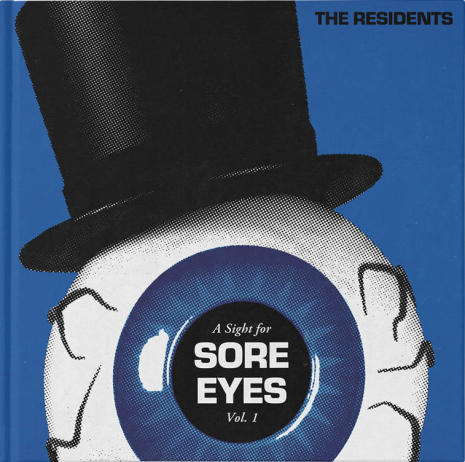
‘A Sight for Sore Eyes, Vol. 1’
I love the Residents’ A Sight for Sore Eyes book, and I notice it’s hopefully titled “Volume One.” Are there gonna be more volumes, as far as you know?
The plan is three volumes, and I know that this one has done pretty well. So that should guarantee at least Volume Two [smiles], we’ll see from there. Everybody around here is extremely happy with it. As the keeper of the visual archives, I worked with Aaron [Tanner] pretty closely, and really enjoyed working with him and thought he did a fantastic job.
Do you ever come across stuff in the archives that’s surprising to you, doing this kind of stuff, or is it all pretty familiar to you?
I’ve run across stuff that I haven’t seen for a long time, that can surprise me: “Oh, I kept that!” [Laughs] I used to say that all the Residents’ imagery neatly divided up into two twenty-year segments. Well, now, it’s a lot closer to a twenty-year and a thirty-year [segment]. The first twenty years was all analog. I went digital with Photoshop and those tools in the early to mid-Nineties, so there’s not as many interesting artifacts.
I always tell people, if you are a production artist trying to create things that have to be reproduced, digital tools are fantastic. If you like the weird, old, crazy artifacts that got spun off one way or another through analog work, well, you don’t really get that very much anymore. Like so many things in life, there’s an upside and a downside.
I have a cabinet right over here with photographs in it, and a lot of those have never been digitized. Sometimes, I can find myself going back and looking for something, and that’s what can really surprise me—that picture got made, or that picture got made. Because, like I say, a lot of that stuff has never been digitized.
I’ve donated a lot of the Residents’ analog tape archive to the Museum of Modern Art, and at some point, I expect to be donating all of this film stuff, and I’m hoping that I can talk them into digitizing all of it so I will actually have it all in that form.
It must be a massive amount of stuff at this point.
It’s a lot. It’s a lot of stuff, yeah.
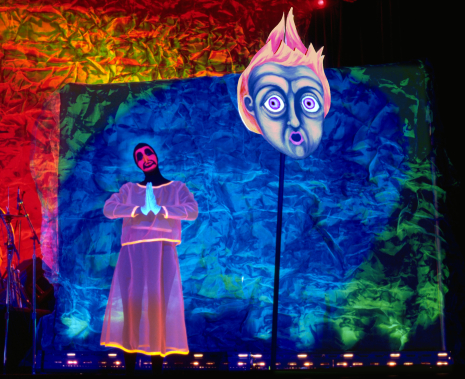
‘Burn Baby Burn’ (courtesy of Cherry Red Records)
Richard Anderson
It just happened that it was originally going to be six, then seven, then eight, then nine [discs], because people reached out to Carla Fabrizio, and she ended up coming up with a whole disc’s worth of extra stuff, and also Hardy would ask this guy Chris Kellas to record shows, and he recorded the [two-disc] Wormwood at the Fillmore show. That was kind of a late addition, so it kind of leapt from six to nine discs at the very last minute, actually.
And it was particularly interesting because the Fillmore show is different to the tour. It was just the album, whereas obviously for the tour they wrote a whole load of other songs.
And there’s the gamelan orchestra.
Yeah, right. I think the idea behind it, and with all of the box sets, really, is to show [how] these Residents live projects tend to evolve. They seem to do like a couple of dress rehearsals in San Francisco, figure out what was right and what was wrong about it, change it for the tour. So the idea for each of those is to, in a perfect world, I suppose, play them almost chronologically: demos, first live show, later demos, album, tour, whatever it is. Wormwood’s a strange one, obviously, ‘cause they went back and re-recorded the Roadworms thing in the middle of a tour.
So they themselves weren’t huge on the album; for some strange reason, they put the album out, and immediately decided to write loads more songs, and then re-record it whilst they were on tour. So it’s a strange project in the first place. In the early 2000s, Hardy talked about revisiting it and completely reworking it, and then nothing came of it, so this is, I suppose, the extension of that idea. It just grew and grew.
More after the jump…









